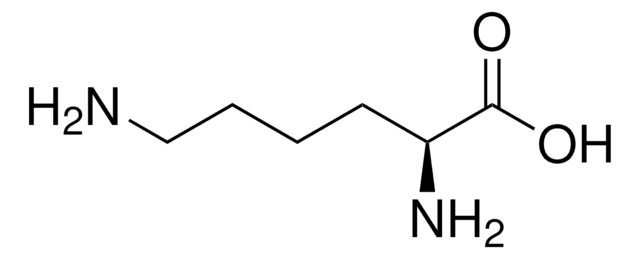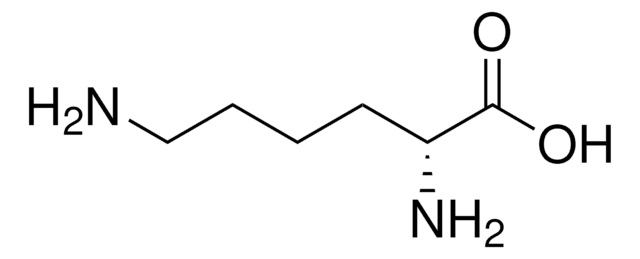L5501
L-Lysin
≥98% (TLC), suitable for ligand binding assays
Synonym(e):
(S)-2,6-Diaminocaprosäure
About This Item
Empfohlene Produkte
product name
L-Lysin, ≥98% (TLC)
Assay
≥98% (TLC)
Form
powder
Methode(n)
ligand binding assay: suitable
Farbe
white to off-white
mp (Schmelzpunkt)
215 °C (dec.) (lit.)
Löslichkeit
H2O: soluble
SMILES String
NCCCC[C@H](N)C(O)=O
InChI
1S/C6H14N2O2/c7-4-2-1-3-5(8)6(9)10/h5H,1-4,7-8H2,(H,9,10)/t5-/m0/s1
InChIKey
KDXKERNSBIXSRK-YFKPBYRVSA-N
Suchen Sie nach ähnlichen Produkten? Aufrufen Leitfaden zum Produktvergleich
Allgemeine Beschreibung
Anwendung
- als Zusatz in Zellkulturmedien
- als Substrat für Enzyme wie die L-Lysin-Oxidase (EG 1.4.3.14)
- als Komponente von Polylysin-Polymeren
- als Substrat für Untersuchungen des Oxidations- und Glykationsmechanismus
- bei der Herstellung von Cobalt-Lysin
Lagerklassenschlüssel
11 - Combustible Solids
WGK
WGK 1
Flammpunkt (°F)
Not applicable
Flammpunkt (°C)
Not applicable
Persönliche Schutzausrüstung
Eyeshields, Gloves, type N95 (US)
Analysenzertifikate (COA)
Suchen Sie nach Analysenzertifikate (COA), indem Sie die Lot-/Chargennummer des Produkts eingeben. Lot- und Chargennummern sind auf dem Produktetikett hinter den Wörtern ‘Lot’ oder ‘Batch’ (Lot oder Charge) zu finden.
Besitzen Sie dieses Produkt bereits?
In der Dokumentenbibliothek finden Sie die Dokumentation zu den Produkten, die Sie kürzlich erworben haben.
Kunden haben sich ebenfalls angesehen
Protokolle
Separation of L-Alanine; Glycine; L-Valine; L-Leucine; L-Isoleucine; L-Proline; L-Methionine; L-Serine; L-Threonine; L-Phenylalanine; L-Aspartic acid; L-4-Hydroxyproline; L-Cysteine; L-Glutamic acid; L-Asparagine; L-Lysine; L-Glutamine; L-Histidine; L-Tyrosine; L-Tryptophan; L-Cystine
Unser Team von Wissenschaftlern verfügt über Erfahrung in allen Forschungsbereichen einschließlich Life Science, Materialwissenschaften, chemischer Synthese, Chromatographie, Analytik und vielen mehr..
Setzen Sie sich mit dem technischen Dienst in Verbindung.







